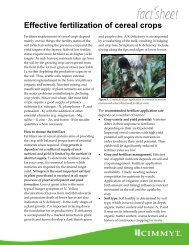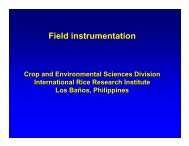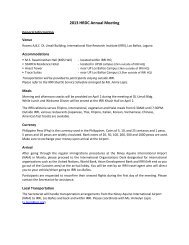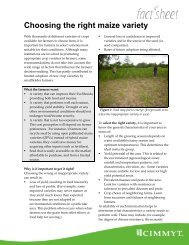Bacterial Leaf Streak - Rice Knowledge Bank - International Rice ...
Bacterial Leaf Streak - Rice Knowledge Bank - International Rice ...
Bacterial Leaf Streak - Rice Knowledge Bank - International Rice ...
Create successful ePaper yourself
Turn your PDF publications into a flip-book with our unique Google optimized e-Paper software.
<strong>Bacterial</strong> <strong>Leaf</strong> <strong>Streak</strong><br />
<strong>Bacterial</strong> <strong>Leaf</strong> <strong>Streak</strong> – Page 1 of 2<br />
Causal organism<br />
<strong>Bacterial</strong> leaf streak (BLS) is caused by Xanthomonas oryzae pv. oryzicola. The bacterium is rodshaped<br />
with an average dimension of 1.2 × 0.3 to 0.5 µm. On nutrient agar, bacterial colonies are pale<br />
yellow, circular, smooth, and convex, and have an entire margin (Webster and Gunnell 1992).<br />
rice fact sheets<br />
Distribution<br />
<strong>Bacterial</strong> leaf streak occurs in tropical and subtropical regions of Asia, Africa (including Madagascar),<br />
South America, and Australia (Webster and Gunnel 1992, Niño-Liu et al 2006, Wonni et al 2011).<br />
Symptoms<br />
Symptoms initially appear as small, water-soaked, linear lesions between leaf veins. These streaks are<br />
initially dark green (Fig. 1) and later become light brown to yellowish gray (Fig. 2). BLS lesions are<br />
translucent when held against the light. Entire leaves may become brown and die when the disease is<br />
very severe. Under humid conditions, yellow droplets of bacterial ooze, which contain masses of<br />
bacterial cells, may be observed on the surface of leaves (Fig. 3).<br />
Fig. 1. Water-soaked<br />
and green lesions of<br />
bacterial leaf streak.<br />
Fig. 2. Enlarged and<br />
coalesced lesions of<br />
bacterial leaf streak.<br />
Fig. 3. <strong>Bacterial</strong> ooze on the surface<br />
of an infected leaf. Photo courtesy of<br />
Dindo King Donayre, Philippine <strong>Rice</strong><br />
Research Institute.<br />
<strong>Bacterial</strong> leaf streak may be confused with narrow brown spot. BLS lesions are usually thinner than<br />
those of narrow brown spot, which is caused by a fungus. When the advancing part of the streaks are<br />
cut and placed in a glass with water, a mass of bacterial cells can usually be seen oozing out of the leaf,<br />
which makes the water turbid after 5 minutes. Moreover, narrow brown spot lesions are not translucent,<br />
nor do they produce bacterial ooze.<br />
<strong>Bacterial</strong> leaf streak may also be confused with bacterial blight usually at the early stage of infection,<br />
particularly if lesions of both diseases occur on the same leaf. The diseases can be distinguished<br />
through biochemical, pathogenicity, or serological tests. PCR primers were recently developed to<br />
distinguish the two bacterial pathogens (Lang et al 2010).<br />
Epidemiology and ecology<br />
<strong>Bacterial</strong> leaf streak is a seedborne disease (Xie and Mew 1998) but transmission from seeds to plants<br />
has not yet been clearly demonstrated. Sowing infected seeds may produce infected seedlings, and<br />
contribute to inoculum and disease transfer from one cropping season to another. The pathogen infects<br />
several species of wild rice (Ou 1985) and can survive on infected crop residues, volunteer plants, and<br />
weeds. Frequent rainfall favors the disease (Ou 1985). Rain splash facilitates the dispersal of bacteria<br />
from infected leaves and causes infection on neighboring healthy tissues. Rainfall with strong winds can<br />
For more information, visit the <strong>Rice</strong> <strong>Knowledge</strong> <strong>Bank</strong>: http://www.knowledgebank.irri.org<br />
Developed with input from: N.P. Castilla, S. Savary and A. Sparks<br />
Produced by the <strong>International</strong> <strong>Rice</strong> Research Institute (IRRI) • © 2012, IRRI, All rights reserved • Feb 2012
<strong>Bacterial</strong> <strong>Leaf</strong> <strong>Streak</strong> – Page 2 of 2<br />
cause water-soaking and wounds, which facilitate the entry of bacteria through stomata. BLS bacteria<br />
may also spread in the field through irrigation water (Ou 1985). The application of excessive amounts of<br />
nitrogen fertilizer favors the disease (Seshagiri Rao and Devadath 1980). The disease is also favored by<br />
warm temperature (25 to 35 °C) and high relative humidity (Webster and Gunnell 1992).<br />
Management<br />
Breeding resistant varieties is the most efficient way to control bacterial leaf streak. Highly resistant rice<br />
varieties are available and have been used as parents in breeding programs. <strong>Bacterial</strong> leaf streak<br />
resistance appears to be quantitative (Khush 1977), controlled by a number of QTLs (Tang et al 2000,<br />
Han et al 2008). Studies in China show that major genes may also be involved (Han et al 2008).<br />
rice fact sheets<br />
Other options for managing bacterial leaf streak include<br />
<br />
<br />
<br />
<br />
<br />
Keeping fields clean—removing weed hosts and plowing under rice stubble, straw, rice<br />
ratoons, and volunteer seedlings, which may be infected by the pathogen;<br />
Using a balanced amount of plant nutrients, especially nitrogen;<br />
Ensuring good drainage of conventionally flooded fields and nurseries;<br />
Draining the field during severe flooding; and<br />
Drying the field during the fallow period to kill the bacteria and reduce the amount of inoculum<br />
in the soil and plant residues.<br />
References<br />
Han QD, Chen ZW, Deng Y, Lan T, Guan HZ, Duan YL, Zhou YC, Lin MC, Wu WR. 2008. Fine mapping of qBlsr5a,<br />
a QTL controlling resistance to bacterial leaf streak in rice. Acta Agron. Sin. 34:587-590.<br />
Khush GS. 1977. Breeding for resistance in rice. In: Day PR, editor. The genetic basis of epidemics in agriculture.<br />
Academy of Sciences, New York. p 296-308.<br />
Lang JM, Hamilton JP, Diaz MGQ, Van Sluys MA, Burgos MRG, Vera Cruz CM, Buell CR, Tisserat NA, Leach JE.<br />
2010. Genomics-based diagnostic marker development for Xanthomonas oryzae pv. oryzae and X. oryzae pv.<br />
oryzicola. Plant Dis. 94:311-319.<br />
Niño-Liu DO, Ronald PC, Bogdanove AJ. 2006. Pathogen profile. Xanthomonas oryzae pathovars: model pathogens<br />
of a model crop. Mol. Plant Pathol. 7:303-324.<br />
Ou SH. 1985. <strong>Rice</strong> diseases. Second edition. Commonwealth Mycological Institute, C.A.B. <strong>International</strong>, Farnham<br />
Royal, Slough, UK. 380 p.<br />
Seshagiri Rao C, Devadath S. 1980. Effect of nitrogen and duration of rice cultivars in relation to bacterial leaf streak<br />
incidence. Oryza 17:42-47.<br />
Tang D, Wu W, Li W, Lu H, Worland AJ. 2000. Mapping of QTLs conferring resistance to bacterial leaf streak in rice.<br />
Theor. Appl. Genet. 101:286-291.<br />
Webster RK, Gunnell PS. 1992. Compendium of rice diseases. American Phytopathology Society, St. Paul,<br />
Minnesota. 62 p.<br />
Wonni I, Ouedraogo L, Verdier V. 2011. First report of bacterial leaf streak caused by Xanthomonas oryzae pv.<br />
oryzicola on rice in Burkina Faso. Plant Dis. 95:72.<br />
Xie GL, Mew TW. 1998. A leaf inoculation method for detection of Xanthomonas oryzae pv. oryzicola from rice seed.<br />
Plant Dis. 82:1007-1011.<br />
For more information, visit the <strong>Rice</strong> <strong>Knowledge</strong> <strong>Bank</strong>: http://www.knowledgebank.irri.org<br />
Developed with input from: N.P. Castilla, S. Savary and A. Sparks<br />
Produced by the <strong>International</strong> <strong>Rice</strong> Research Institute (IRRI) • © 2012, IRRI, All rights reserved • Feb 2012<br />
2


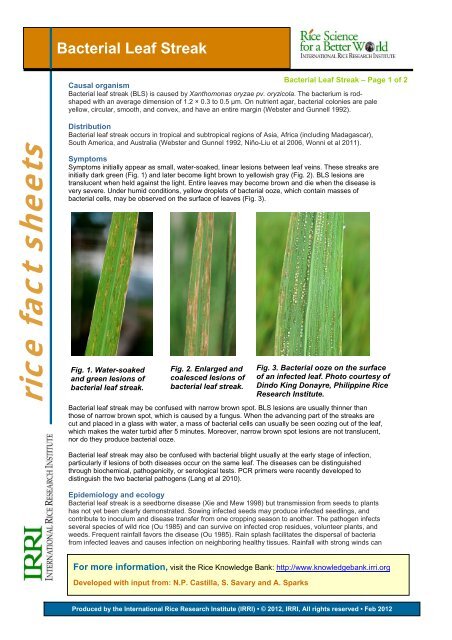


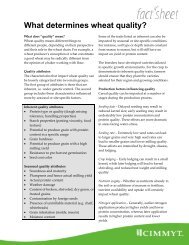


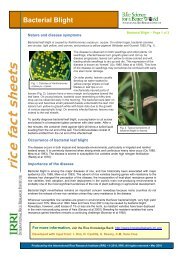

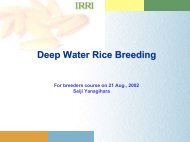
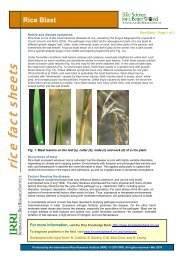
![International Standards' Organization â Rice Specification [ISO 7301]](https://img.yumpu.com/36696862/1/190x245/international-standards-organization-a-rice-specification-iso-7301.jpg?quality=85)

